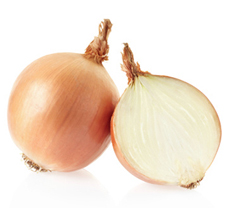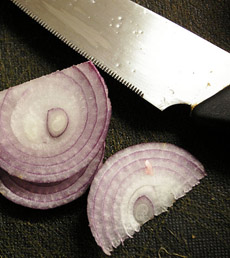TIP OF THE DAY: 7 Tips For Slicing Onions
 For starters, slice onions vertically. Photo courtesy Care2.com. |
An onion is a thing of beauty—until you slice into it and the fumes assault your eyes.
But that doesn’t need to be. Here are some tips to minimize the impact of the acrid gas that’s released when you slice into an onion. |
|
|
|
||
|
WHY DO ONION VAPORS BURN YOUR EYES?
Chopping an onion causes damage to the cells. Enzymes called alliinases—present in all members of the Allium genus*—break down amino acids (sulfoxides) and generate sulfenic acids. These further react to produce a volatile gas known as the onion lachrymatory factor or LF. LF diffuses through the air and activates sensory neurons in eye, causing that burning, stinging sensation. Tear glands come to the defense, producing tears to dilute and flush out the irritant. If you slice onions a lot, your eyes will become more tolerant (they may build up a tolerance to the LF). The amount of LF differs among onion varieties. That’s why some onions are real “burners” and others are milder. Sweet onions, for example, grow in soils that are low in sulphur and don’t produce much alliinase. |
 Try the different techniques to see what works best for you. Photo by Lali Masriera | Wikimedia. |
|
|
*The Allium genus includes chives, garlics, leeks and onions.
|
||


